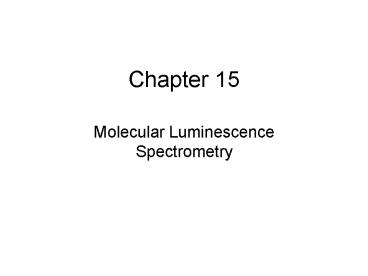Molecular Luminescence Spectrometry
1 / 25
Title:
Molecular Luminescence Spectrometry
Description:
Chapter 15 Molecular Luminescence Spectrometry Chapter 15 Molecular Luminescence Spectrometry A very sensitive and selective instrumental technique with some of the ... –
Number of Views:180
Avg rating:3.0/5.0
Title: Molecular Luminescence Spectrometry
1
Chapter 15
- Molecular Luminescence Spectrometry
2
Fluorescence and Phosphorescence
A very sensitive and selective instrumental
technique with some of the lowest LOD's for
molecules that luminesce (not all do!) - down to
single-molecule detection.
diamagnetic diamagnetic paramagnetic
isoelectronic in external magnetic field isoelectronic splits into 3 energy levels
short (ns) lifetimes "allowed" longer (?s or longer) lifetimes "forbidden"
large ? small ?
3
Energy Level Diagrams
(Jablonski Diagrams)
ps
ps
Note fluorescence, phosphorescence, and
non-radiative decay can all occur simultaneously
depending on the "quantum yields".
4
Quantum Yields
The quantum yield for a given process is the
ratio of the number of molecules that undergo a
particular process to the total number of excited
states.
S1
T1
So
5
Vibrational Relaxation
S1 (?)
S1 (?)
collisions
So (?)
So (?)
Kasha's Rule fluorescence in fluid solution
always occurs from the lowest vibrational level
of the 1st excited singlet state.
?
H
e-e
e-v
e-t
C O
.
H
solvent molecules
6
Internal Conversion
S3
Favored by overlapping vibrational levels.
S2
S1
So
Intersystem Crossing
Change in spin state from a singlet to a triplet
and vica-versa.
S1
T1
So
Heavy atom effect atoms and small molecules
such as Hg, Br2, I2, and O2 have large
spin-orbit coupling that helps flip spin.
7
Luminescence Lifetimes
- unique and useful for identification
- inversely proportional to ?
- Co initial population of the excited state
- k 1st order rate constant (units s-1)
Co
excited state population C ?
???
time ?
8
Fluorescence and Structure
Most intense from molecules containing multiple
aromatic rings, ??? transitions, and structural
rigidity.
?f 1.0
no fluorescence
?f 0.2
fluorescence
9
Illustration of the Heavy Atom Effect
10
Emission and Excitation Spectra
excitation spectra measure luminescence at a
fixed wavelength while scanning the excitation
wavelengths. emission spectra - excite at a fixed
wavelength while scanning the luminescence.
overlap at the 0-0 band.
11
Instruments for Measuring Fluorescence and
Phosphorescence
12
Xe Arc Lamps
http//en.wikipedia.org/wiki/ImageXenon_short_arc
_1.jpg
13
Spectrofluorometers
14
Corrected Excitation Spectra
The absorbance compensating cell contains the dye
molecule Rhodamine B which absorbs all
wavelengths equally and emits in a pattern that
mimics the variation in the lamp output. The
corrected excitation spectra are produced by
dividing the raw spectrum with the Rhodamine B
spectrum.
15
Phosphorimeters
16
Selectivity
The ability to distinguish and identify different
molecules based on differences in luminescence
spectra. Frequently enhanced by cooling the
sample.
17
Effect of Concentration on Fluorescence Intensity
Po
Pt
Pf
Converting to base e and expanding e-?bc in a
MacLaurin Series Pf ?fPo(1 2.303e-?bc) Pf
?fPo2.303?bc (2.303?bc)2/2!
(2.303?bc)3/3! ..
Pf ?fPa ?f(Po Pt) ?fPo(1 Pt/Po)
PtPa
from Beers Law
10-?bc
Pf ?fPo 2.303?bc
so Pf ?fPo(1 10-?bc)
18
Absorbance vs. Fluorescence Signals
Why fluorescence is inherently more sensitive.
Pf ?fPo 2.303?bc
A -log P/Po
19
Comparing UV-Vis to Fluorescence LOD's
anthracene (MW 178)
20
Applications
- Fluorimetric Determination of Inorganic Species
- Fluorimetric Determination of Organic Species
- Forensics (latent blood stains - luminol
chemiluminescence) - Fluorescence Imaging Methods
21
Fluorimetric Determination of Inorganic Species
22
Fluorimetric Determination of Organic Species
Polynuclear Aromatic Hydrocarbons (PAH's) in the
environment.
anthracene
1,2-benzanthracene
perylene
23
Applications to Forensics
http//en.wikipedia.org/wiki/Luminol
24
Fluorescence Imaging Methods
http//www.microscopyu.com/articles/fluorescence/f
luorescenceintro.html
25
(No Transcript)































